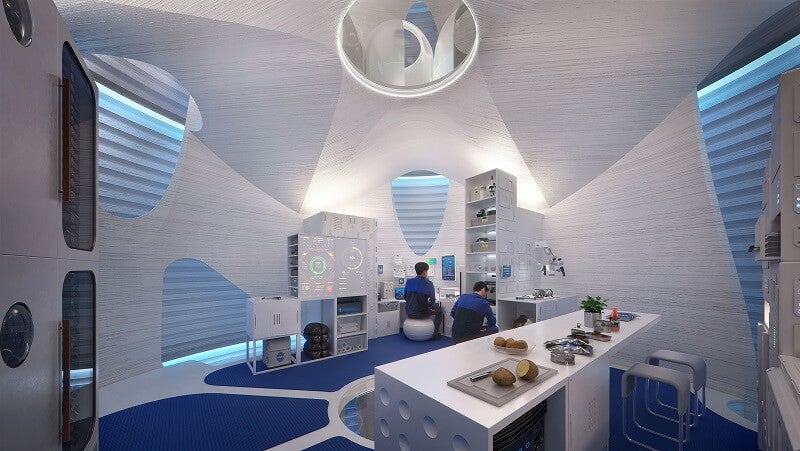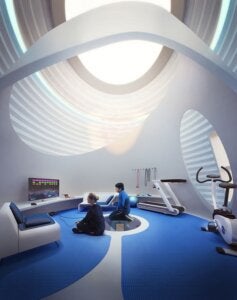Last month, a 3D printed house that can float on a pontoon was unveiled in the Czech Republic. Last 12 months, work began on a community of 3D printed houses for low-income households in Mexico. While constructing properties with 3D printers is changing into extra scalable, it’s additionally nonetheless a enjoyable strategy to mess around with distinctive designs and futuristic ideas for our residing areas.
It doesn’t get far more futuristic than residing on Mars—and guess what? There’s a 3D printed residence for that, too. In truth, there are just a few; final 12 months noticed the conclusion of a contest held by NASA known as the 3D Printed Habitat Challenge.
The long-running competitors, began in 2015, tasked contributors with creating properties that may be viable to construct on Mars. Teams needed to take into account not simply the know-how they’d use, however what sort of materials shall be obtainable on the Red Planet and what variety of includes a Martian residence might want to have for a human to outlive (and ideally, to outlive comfortably); the buildings must be robust sufficient to make it by a meteor collision, for instance, and in a position to maintain an environment very totally different than the one simply outdoors their partitions.

The prime prize ($500,000) went to AI Space Factory, a New York-based structure and building applied sciences firm centered on constructing for area exploration. Their dual-shell, four-level design known as Marsha, and in contrast to Martian habitats we’ve seen on the huge display or examine in sci-fi novels, it’s neither a dome nor an underground bunker. In truth, it sits totally above floor and it appears like a cross between a hive and a large egg.
The group selected the hive-egg form very intentionally, saying that it’s not solely optimized to deal with the stress and temperature calls for of the Martian ambiance, however constructing it with a 3D printer shall be simpler as a result of the printer gained’t have to maneuver round as a lot as it will to construct a construction with a bigger footprint. That means much less threat of errors and a quicker constructing pace.
“It’s important to be structurally efficient as a shape, because that means you can use less material,” said David Malott, AI Space Factory’s founder and CEO. “If you think about an eggshell on Earth, [it’s] a very efficient shape. The eggshell can be very, very thin, and still it has the right amount of strength.”

The residence’s format is sort of a multi-level townhouse, besides with some Mars-specific tweaks; the first flooring is each a preparation space, the place occupants can get suited up earlier than heading outdoors, and a “wet lab” for analysis. There’s a rover docking port simply outdoors the prep space, hooked up to the home.
On the second flooring is what I’d take into account the most vital room—the kitchen—and the third flooring has a backyard, rest room, and sleeping pods that take the place of bedrooms (sorry, no area in your vintage dresser or Ikea desk right here). The prime flooring is a rec space the place you possibly can recreate both by watching TV or exercising—or maybe each concurrently.
It took 30 hours to construct a one-third scale mannequin of the residence, however this doesn’t imply it will take 90 hours to construct the actual factor; printing throughout the contest was finished in 10-hour increments, and since the mannequin comprises all the similar structural points of the full-size residence, the 3D printer would simply have to develop its reachable floor space and top to print the actual factor.
If all goes as deliberate (which, actually, there are not any plans but; simply concepts), there shall be lots of materials on hand to construct the actual factor in the actual place (Mars, that’s). AI Space Factory collaborated with a supplies design firm known as Techmer PM to provide you with a super-strong combine of basalt fiber—which might come from rocks on Mars—and a renewable bioplastic that might be created from vegetation grown on Mars. In NASA’s assessments, the materials was proven to be stronger and extra sturdy than concrete and extra proof against repeated freezes and thaws.
The firm was set to open an Earth model of Marsha, known as Tera, in upstate New York this previous March, and other people leaped at the chance to pay $175-500 to sleep in the construction for an evening; however the plans had been derailed by the coronavirus pandemic, and the firm hasn’t but introduced a re-opening of the Earthbound cabin.
Image Credit: AI Space Factory
This article originally appeared on Singularity Hub, a publication of Singularity University.







